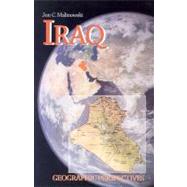
After September 11, 2001, Saddam Hussein's regime in Iraq once again came into the global spotlightA geographic perspective emphasizing regional patterns can provide a useful framework for understanding Iraq.
To understand Iraq's geography, it is first necessary to appreciate its absolute and relative locationIraq shares borders with six countries Iraq has limited access to the seaIraq is slightly larger in area than California
Iraq has four major physiographic regions: desert, uplands, highlands, and an alluvial plainDeserts cover over 40 percent of Iraq's area, especially in the western and southern parts of the countryThe Tigris and Euphrates Rivers, the lifeblood of Iraq, are vital to human populations and agricultural activity
Iraq has three distinct climatic zones: subtropical desert, subtropical steppe, and dry summer subtropicalIraq's deserts are extremely hot and dry in the summer and cool and dry in the winterPrecipitation is limited, with even the wettest areas getting less than 30 inches per yearCold is a significant hazard in the northern mountainsSandstorms and dust storms are common, especially in the desertsSpring flooding is a real hazard in many areas
Iraq is largely devoid of significant natural vegetationMinor forest resources, already significantly impacted by human activity, exist in the northern mountainsThe most unique natural biome in Iraq is the marshland area of the lower Tigris and Euphrates, but this area was damaged by Iraqi government policies in the 1990s that aimed at reducing populations in the region
Iraq's history dates back to one of the earliest civilizations, in MesopotamiaIraq's history is marked by periods of prosperity interspersed with eras of conquest and destructionSaddam Hussein came to power in the 1970s with the support of Sunni Muslims, who had been relatively favored since the times of British control
Islam is the dominant religion in Iraq, but there are divisions mainly among Shiite and Sunni groupsIraq is the home of many important Shiite holy sites, including Karbala and NajafArabic is spoken by 80 percent of the populationKurdish languages are spoken by nearly 20 percent of IraqisThe uniqueness of Kurdish culture goes beyond language differences
Saddam Hussein's quarter-century in power reflected rule through shrewd politics and the ruthless destruction of any oppositionThe two strongest sources of opposition during the Saddam Hussein era were the Kurdish populations in the North and Shiite Muslims in the South Although a minority, Sunni Muslims dominated politics when Saddam Hussein was in powerKurdish politics has often been characterized by internal disagreements and fighting
Based solely on oil reserves, Iraq is one of the richest countries in the worldBecause of United Nations sanctions and governmental neglect, the Iraqi people are the poorest in the regionIraq has almost no capacity to grow its own food
Iraq's population is not uniformly distributed; it is clustered in the cities of Baghdad, Mosul, and BasraIraq's population is growing fast, creating a large population under age 14Demographic statistics reveal the poor quality of health care in Iraq
Infectious diseases are endemicPublic health systems are in complete disarray, increasing disease and mortality ratesFood and water in Iraq is often unsafePoor nutrition is a major cause of health problemsHeat and cold also pose a human health risk in the area
The New copy of this book will include any supplemental materials advertised. Please check the title of the book to determine if it should include any access cards, study guides, lab manuals, CDs, etc.
The Used, Rental and eBook copies of this book are not guaranteed to include any supplemental materials. Typically, only the book itself is included. This is true even if the title states it includes any access cards, study guides, lab manuals, CDs, etc.